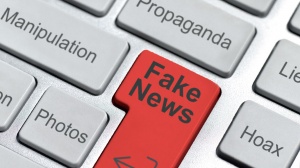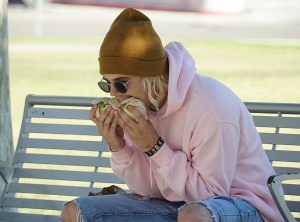Fake News
Fake News is a fairly new term given to certain news articles, web posts, pictures, etc.. that intentionally try to spread false information. This false information is usually aimed at damaging a large entity or famous person, however anyone could fall victim. There can be many reasons to create fake news articles but the main ones are to discredit/damage someone or something and to make money off the spreading of the article itself. There are a plethora of ethical issues present in the context of fake news. Yellow Journalism and similar media practices have existed for centuries but the emergence of fake news specifically has ushered in new ethical dilemmas altogether. The biggest ethical problem in this context is that in today's day and age anyone can be a self-proclaimed journalist by posting 'news' online, the main spreaders of fake news are not journalists looking for attraction but are individuals either looking to make money or to deceit others for comedic or political appeal. These individuals lack the ethics and morals of typical journalists, more than likely no one will know their true identity and so anonymity and a lack of an ethical code -along with the average person's gullibility- has created the breeding for fake news observed on social media today.
Contents
Background
History
Fake news became a household term in late 2016 - early 2017 as the US presidential candidates, Hilary Clinton and Donald Trump, began to use the term in speeches and social media posts. Who coined the term first is unknown but the origin of the first fake news articles stemmed from a small town -Veles- in Macedonia.[1] It appears that the young adults of Veles figured out a get-rich-quick scheme by pumping out fake news articles to Facebook to gain the advertising money available on the site. Thus a group of teenagers from Macedonia ushered in the era of fake news, writing many articles mainly centered around the 2016 US presidential election. Being the hottest topic of mid-late 2016, any kind of fake news article about Hilary Clinton or Donald Trump was sure to sell online. Stories such as "Pope Francis endorses Donald Trump" and "FBI Agent in Clinton email case found dead" went viral instantly.
Types
Fake news comes in many different forms, there are six easily identifiable types of it: Click bait, Propaganda, Satire, Sloppy Journalism, Misleading Headlines, and Biased News.[2] Click bait is defined as stories that intentionally use a ridiculous headline to gain site views at the price of truth and actual content. Propaganda is intentionally writing a story in a biased slant in order to achieve some agenda. Satirical fake news is created with the intention of entertainment and comedy. Sloppy Journalism occurs when the writer of an article/post uses unreliable sources containing fake news, it's not necessarily the writer's fault for spreading fake news case but it is their fault for not double-checking their sources. Misleading headlines are similar to Click bait but with more substance within the article. Finally, Biased News stories are created to appeal to peoples pre-existing beliefs. Unlike propaganda these articles are written to gain attention not necessarily to shift beliefs.
Ethical problems with Fake News
Mental and Physical Damage
The writers/creators of fake news are almost always intentionally deceiving their audience in one manner or another. It can be for monetary gain or simply out of boredom, either way the writers are deceiving an audience, misleading them and potentially causing massive problems. Christopher Blair is a prime example of someone who was bored one day and decided to start writing fake news articles to see people's reactions to his outrageous articles. Blair created his own Facebook page, America's Last Line of Defense -a far right-wing page, where he publishes several articles a day, battering liberals in any way possible.[3] Blair's page does contain a warning that the posts are not real but for many readers, this warning goes unnoticed. Sites like these deceive readers, especially adults and the elderly who have more trouble distinguishing truth from hoax online. What Blair is doing is hurting the readers and those around them who either believe the article themselves or have to break the news that these articles are fake to their loved ones. When someone who truly believes the fake news articles they've been reading for awhile learns what it truly is, they struggle to trust any type of news article, at least for a time. This kind of intentional deceit can also lead to violent interactions in the real world as observed in the Pizza Gate scandal in 2016.[4] Incidents such as this can occur again as radical people struggle to understand which articles are real or fake and decide to act on what they believe to be a fact.
Proving a point?
Fake news articles seem to gravitate around celebrities, after all stories about popular individuals will gain more attention than one about George Johnson from Iowa. Justin Bieber has been a headline worthy celebrity for quite some time so a YouTube channel known as Yes Theory decided to do a "challenge", to see if they could get a fake news article to go viral. They decided they would hire a Justin Bieber look-a-like, dress him up to look even more the part, and have him do several mildly infuriating things around Los Angeles.[5] One of the infuriating actions they had the pretend Bieber do was to sit on a park bench and eat a Chipotle burrito from the middle instead of the ends as most people do. Within 48 hours of sending their pictures to popular websites and news editors, the picture was trending on Twitter, Reddit, and was featured on virtually every news channel. The Yes Theory crew had achieved their goal of tricking the world simply for the sake of seeing if they could. No damage was done to anyone -except maybe to the actual Justin Bieber- but fake news is fake news all the same, this picture and following YouTube video showing the process of staging the incident was done with the intention to deceit the general public.Heading text
References
- ↑ Wendling, Mike. “The (Almost) Complete History of 'Fake News'.” BBC News, BBC, 22 Jan. 2018, www.bbc.com/news/blogs-trending-42724320.
- ↑ “Explained: What Is Fake News? | Social Media and Filter Bubbles.” Webwise.ie, 2 July 2018, www.webwise.ie/teachers/what-is-fake-news/.
- ↑ Saslow, Eli. “'Nothing on This Page Is Real': How Lies Become Truth in Online America.” The Washington Post, WP Company, 17 Nov. 2018, www.washingtonpost.com/national/nothing-on-this-page-is-real-how-lies-become-truth-in-online-america/2018/11/17/edd44cc8-e85a-11e8-bbdb-72fdbf9d4fed_story.html.
- ↑ Tandoc, Edson C, et al. “Defining ‘Fake News.’” Digital Journalism, 30 Aug. 2017.
- ↑ Theory, Yes, director. We Fooled the Internet w/ Fake Justin Bieber Burrito Photo. YouTube, YouTube, 28 Oct. 2018, www.youtube.com/watch?v=Vs6In7UtyXY.

